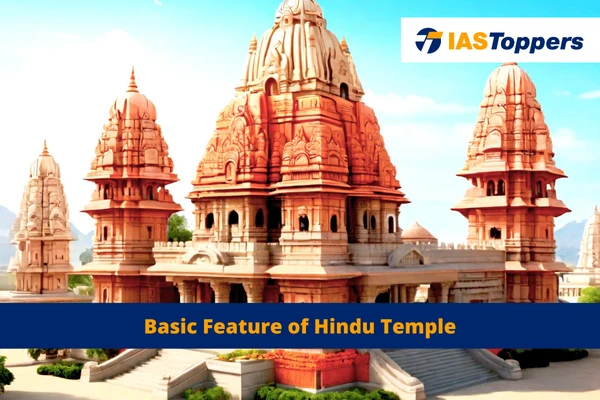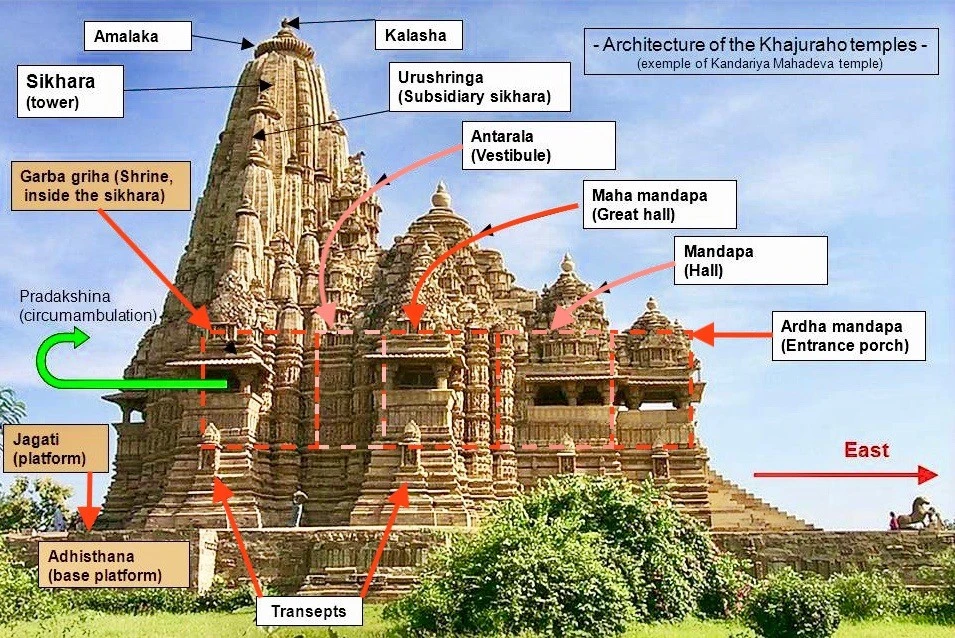Basic Feature of Hindu Temple includes a sanctum or Garbhagriha, which is a special chamber that houses the main icon and is a focal point for rituals. They also have a significant entrance area, known as a mandapa, and are crowned with a spire or tower, known as Shikhar or Vimana, representing the abode of the deity. Additionally, a Vahan, representing the vehicle of the deity, is often placed before the sanctum. In this article, you will learn about Basic Features of Hindu Temple, which are very important topic for GS Paper-1 Ancient India of UPSC CSE Exam. To explore more interesting concepts similar to Basic Feature of Hindu Temple, check out other articles of IASToppers.
Table of Content
- What is the basic feature of the Hindu temple?
- Iconography of Indian Hindu Temples
- Conclusion
- FAQs on basic feature of the Hindu temple
What is the basic feature of the Hindu temple?
The basic form of the Hindu temple is as following:
Sanctum (Garbhagriha)
- Garbhagriha literally means womb-house.
- It was a small cubicle with a single entrance and grew into a larger chamber in time.
- The garbhagriha is made to house the main icon which is itself the focus of much ritual attention.
Entrance
- The entrance to the temple may be a portico or colonnaded hall.
- It incorporates space for a large number of worshippers and is known as a mandapa.
Shikhar/Vimana
- Freestanding temples tend to have a mountain-like spire, which can take the shape of a curving shikhar in North India and a pyramidal tower, called a vimana, in South India.
Vahan
- The vahan is the mount or vehicle of the temple’s main deity.
- Vahan along with a standard pillar or dhvaj is placed axially before the sanctum.
As temples grew more complex, more surfaces were created for sculpture through additive geometry, i.e., by adding more rhythmically projecting, symmetrical walls and niches, without breaking away from the fundamental plan of the shrine.
Iconography of Indian Hindu Temples
- Indian Hindu temples has lots of iconography, showing its rich cultural heritage and religious beliefs of the region.
- Iconography is a branch of art history that involves study of images, symbols, and mythologies associated with religious figures or deities.
- Very often, while the fundamental myth and meaning of the deity may remain the same for centuries, its specific usage at a spot can be a response to its local or immediate social, political or geographical context.
- Every region and period produced its own distinct style of images with its regional variations in iconography.
- Hindu temples are adorned with sculptures and ornament, each with its own set of symbols and attributes.
- Temples often incorporate specific architectural elements such as image that hold symbolic meanings.
- Garbhagriha entrances in Nagara temples often feature river goddesses (Ganga and Yamuna).
- Dvarapalas (doorkeepers) are typically seen on Dravida temple gateways or gopurams.
- Mithunas (erotic images), navagrahas (nine auspicious planets), and yakshas also guard entrances.
- The main divinity’s various forms can be found on sanctum’s outer walls
- Ashtadikpalas, or deities of directions, face the eight primary directions on the outer walls of the sanctum and/or on the outer walls of a temple.
- Smaller shrines surrounding the main temple honor the primary deity’s family or incarnations.
- Ornamental features such as gavaksha, vyala/yali, kalpa-lata, amalaka, and kalasha are utilized in specific ways and locations throughout a temple.
Conclusion
The key elements of basic form of a Hindu temple play a pivotal role in representing the rich cultural heritage, religious beliefs, and mythologies of the region, thereby making them more than just places of worship. Hindu temples are masterpieces of architecture, art, and religious significance. The preservation of these temples is integral not only to honor the past but also to provide future generations with a window into the rich heritage of India’s ancient traditions.
Ref: Source-1
| Other Articles in History & Culture | |
| Orthodox Schools of Indian Philosophy | Kathakali |
| Kharosthi Script and Gupta Script | Guru Nanak |
| Prehistoric Rock Paintings in India | Chalukya Dynasty |
FAQs (Frequently Asked Questions)
What is a Garbhagriha in a Hindu temple?
A Garbhagriha is the sanctum of a Hindu temple, housing the primary deity and serving as the central focus for rituals.
What is the significance of a Shikhar or Vimana in Hindu temple architecture?
The Shikhar or Vimana, the mountain-like spire or tower of a Hindu temple, symbolizes the divine abode of the temple’s main deity.
What role does a Vahan play in Hindu temples?
A Vahan, representing the deity’s vehicle, is often placed before the sanctum, underlining the divine presence and connection.



